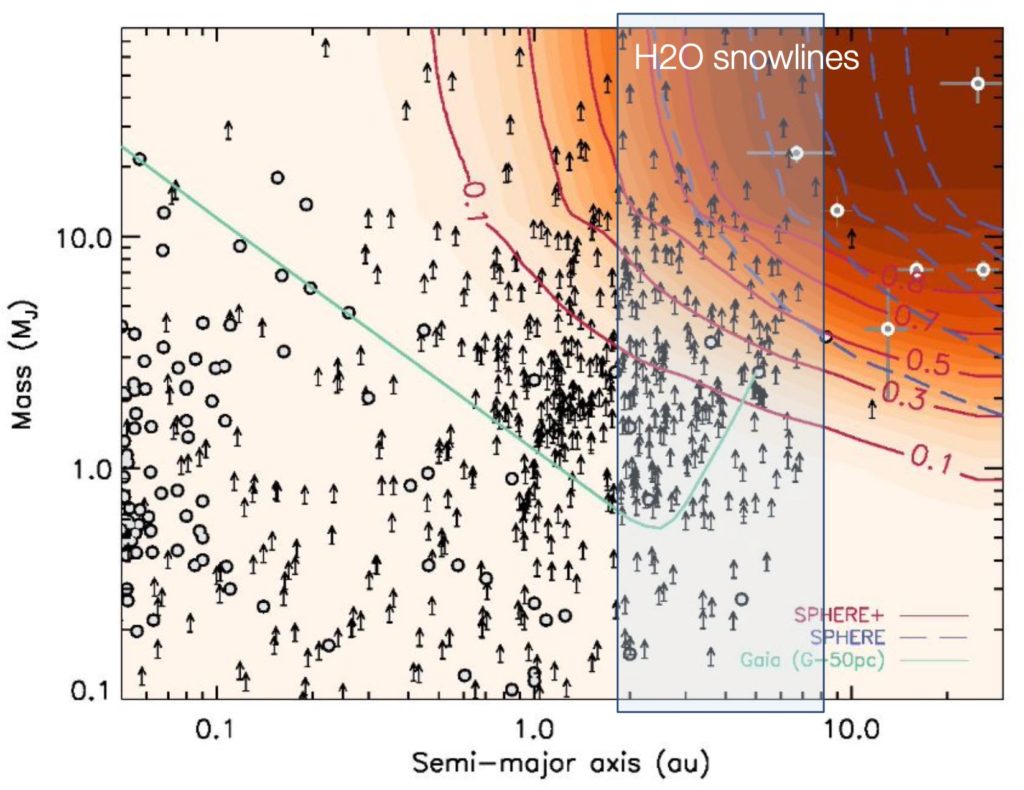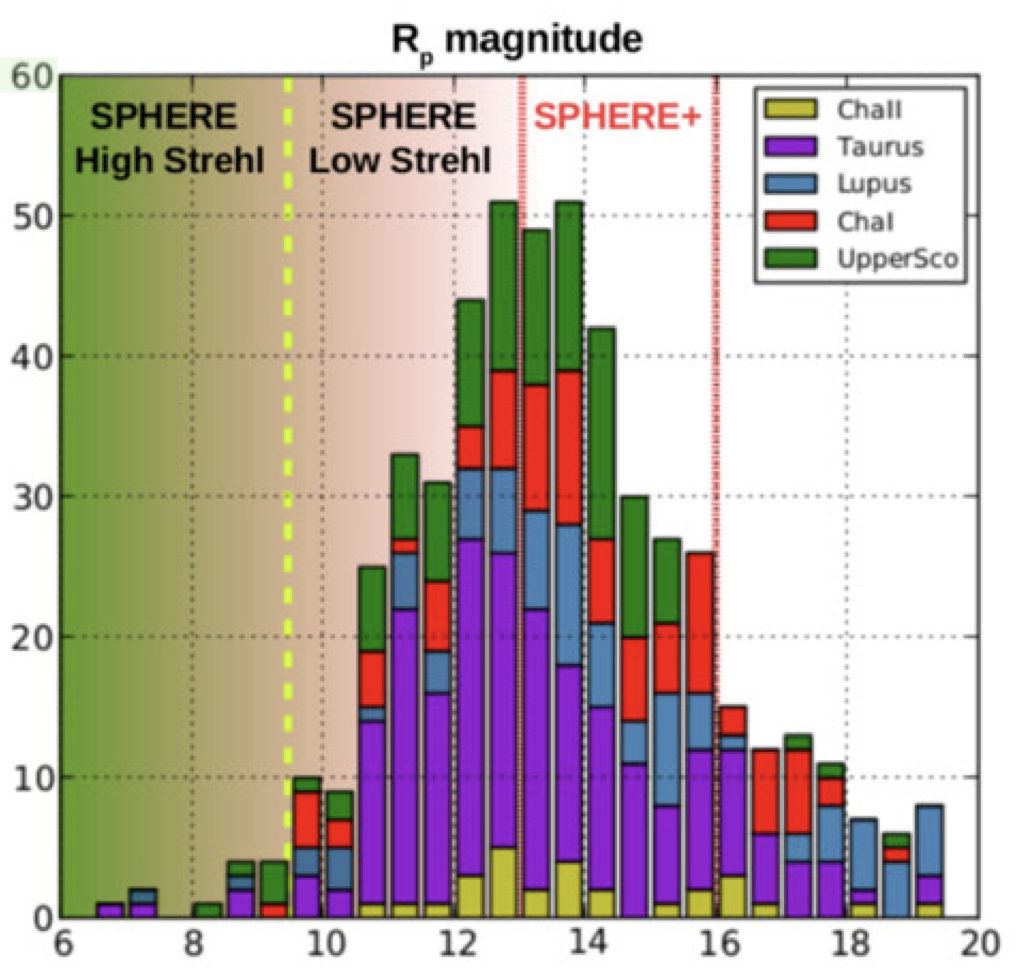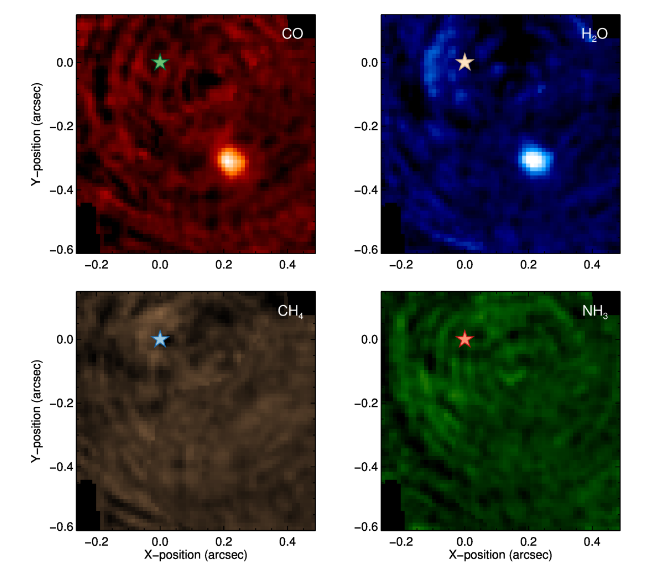1. Demographics of giant planets: bridging the gap down to the snow line (sci.req.1)
SPHERE’s current detection performance enables routine exploration of the population of giant planets located between 10 to 300 au and with masses >2 M_Jupiter. The rate of new exoplanet discoveries remains low despite the large number of stars observed, conclusively demonstrating that the bulk of the massive giant planet population does not extend significantly beyond 10 au. On the contrary radial velocity surveys indicate that the population of giant planets is peaking at a few au from the stars. Gaia will soon provide many more detections in this separation range.
A prime scientific goal of SPHERE+ will be to bridge the gap with indirect techniques by imaging young Jupiter down to the snowline at about 3 au.
SPHERE+ will be able to target young giant planets that will be discovered, or suspected due to astrometric trends, with Gaia Data Release 4, and in the course of radial velocity campaigns. SPHERE+ will also allow a systematic survey of the young, nearby stars observed during the SHINE campaign but at closer physical separations to explore the demographics of giant planets down to 3 au.
As of today, we rely on mass predictions from evolutionary models that are not calibrated at young ages. In concert with RV surveys and Gaia, SPHERE+ will enable a joint determination of the dynamical mass, the luminosity and the spectral energy distribution of young Jupiters at given ages to calibrate for the first time their mass-luminosity relation.
To achieve sci.req.1, SPHERE+ must deliver significantly higher contrasts at closer angular separations than with SPHERE (typically ~1e-5 at 0.1 »).
SPHERE+ will increase the bandwidth of the extreme AO system from 1 to 2 or 3 kHz, and improve the correction of non-common path aberrations and corona- graphic rejection.

2. Imaging young Jupiters in formation (sci.req.2)
The capacity of high angular resolution currently achieved on very young systems, both in scattered light at visible and near IR with SPHERE for instance, and also in thermal emission at sub millimetric wavelengths with ALMA, has revolutionized the observations of planet forming disks. Even if the direct link is difficult to confirm these disks feature many sub-structures, like rings, cavities, spirals and many sorts of asymmetries calling for the presence of perturbers like planets. The only bona fide case discovered with SPHERE and MUSE are the two giant planets around PDS 70 which are in the process of accreting material.
There is a strong interest to observe even younger systems to tackle the very moment when planets start to form. Today many targets in young associations are still unaccessible with SPHERE because they are red and faint fo the AO system to perform efficiently.
SPHERE+ will be unique in its ability to systematically survey the environment of young stars in star-forming regions and to further discover young Jupiters in formation and PDS 70 system analogs.
To achieve sci.req.2, SPHERE+ must allow to observe faint and red targets with R<16 and R-J<4-5.
SPHERE+ will implement an IR Wavefront Sensor operating with a pyramid device and a very low noise detector.

3. Exploring the diversity of young planetary atmospheres (sci.req.3)
Low spectral (Rλ = 30 − 50) resolution observations with the SPHERE Integral Field Spectrograph constrains the basic atmospheric properties of the planets, like the effective temperature, but fits of atmospheric models to low resolution spectra yield significant degeneracies in the determination of additional parameters like the surface gravity, the metallicity, the composition, or the presence of clouds.
Enhanced characterization capabilities in the near IR will allow to resolve individual molecular lines in planet atmospheres, and to study accretion processes at play during planet formation. This is also a way to boost the performance of detection by disentangling the spectral features expected for stars vs. planets.
With SPHERE+, accessing higher spectral resolution will resolve current degeneracies and fully explore the physics of the latest generation of planetary atmospheric models.
To achieve sci.req.3, SPHERE+ must allow spectral resolution of at least Rλ = 1000, in the J and H bands, together with imaging capacity in a reduced field of view (0.5-0.6 »).
SPHERE+ should implement a new IR integral field spectrograph to allow higher spectral resolution.

